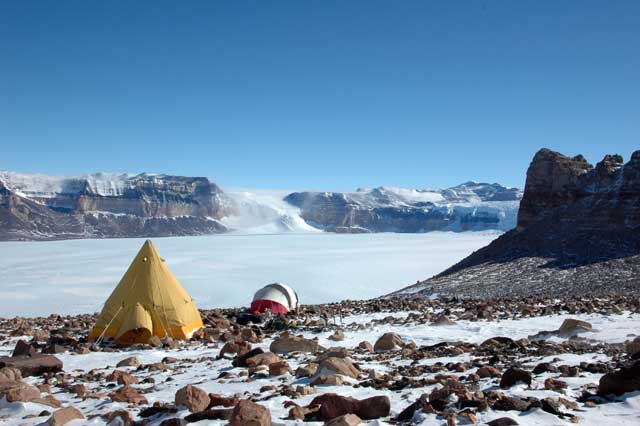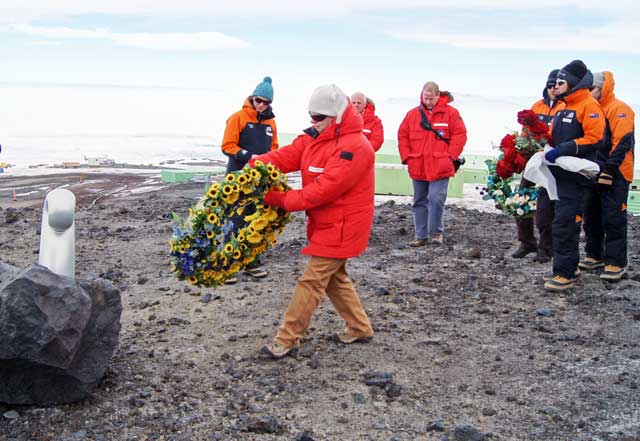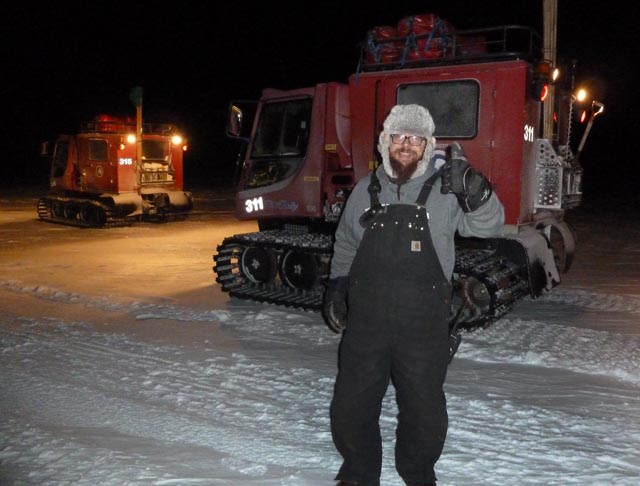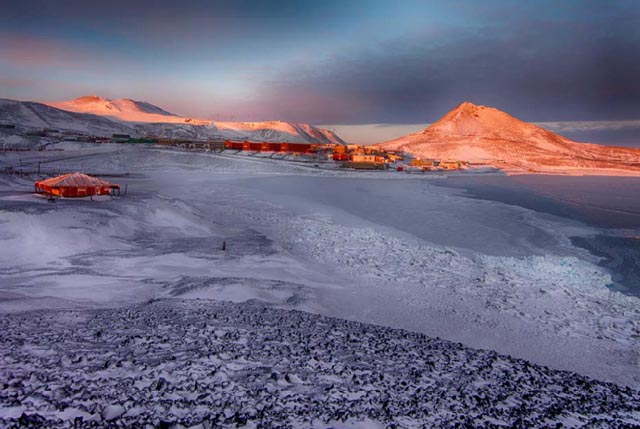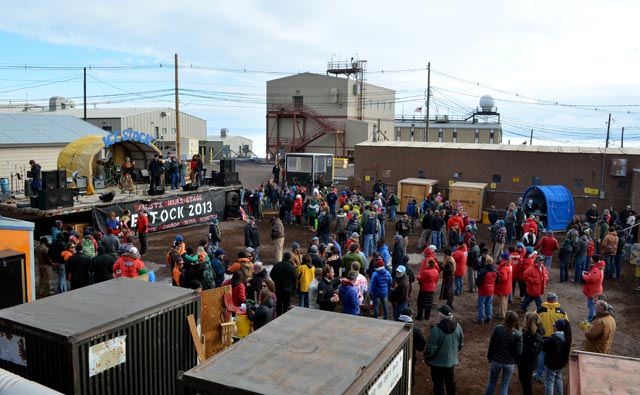|
McMurdo Station Archives - 2013 November ramps up as researchers return to McMurdo StationPosted December 13, 2013
Life at McMurdo Station One of the big projects that was saved at the last minute was a NASA 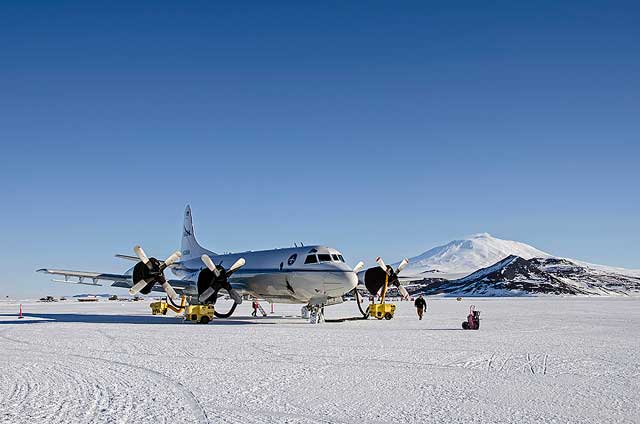
Photo Credit: Michael Studinger/NASA
NASA’s P-3B aircraft flew five missions from McMurdo Station in November.
NASA’s P-3B aircraft The bumpy start to the field season meant a busy month for everyone at station. That was especially true of the kitchen staff, which cooks up a traditional Thanksgiving meal every year. This season the holiday was held a week early due to the shift in airfield operations. About 800 people were on station for the holiday meal, which included 1,300 pounds of turkey and nearly 600 pounds of ham. Sides included more than 500 pounds of mashed potatoes, 265 pounds of stuffing, nearly 300 pounds of green beans and almost 40 gallons of butternut squash soup. Of course, the galley staff is busy year-round. The recent introduction of 24-hour pizza means the bakers are cranking out nearly 100 pies per day. That’s a lot of ’za. Farther afield, work at various field camps is also under way, with more than 80 people at 14 different locations around the continent, most around the McMurdo Dry Valleys A refueling mission to Black Island, where the U.S. Antarctic Program’s Two 5,000-gallon fuel tanks were parked at the base of Black Island. The refueling truck known as Delta Scharen, which sports oversized wheels for snow travel, had to make six round trips between the fuel tanks and the telecommunications facility, each one requiring about three hours. For about the next two months, air traffic between McMurdo and Christchurch, New Zealand, where the U.S. Antarctic Program maintains its off-continent logistics hub, will be limited to LC-130 aircraft flown by the New York Air National Guard The Gap, as the period is known, means there will be less cargo and fewer passengers, as the U.S. Air Force The Gap doesn’t mean a drop in science. Two of the biggest projects of the season are scheduled to get under way soon. The Center for Remote Sensing of Ice Sheets The WISSARD Meanwhile, back at Ross Island, the month wrapped up with a ceremony at New Zealand’s Scott Base McMurdo back on the move with traverses following partial government shutdownPosted November 8, 2013
The 16-day partial government shutdown in October caused many ups and downs at McMurdo Station McMurdo had a different vibe in the first half of October than what most returnees were used to. The only social events were the occasional goodbye parties for the new hires who had been notified they were going to have to leave the continent after just getting to it. Some of the farewells lasted days due to the inclement weather that canceled scheduled flights back to Christchurch. 
Photo Credit: Alasdair Turner
Tractors pull fuel tanks as part of the Marble Point traverse to refuel the helicopter depot.
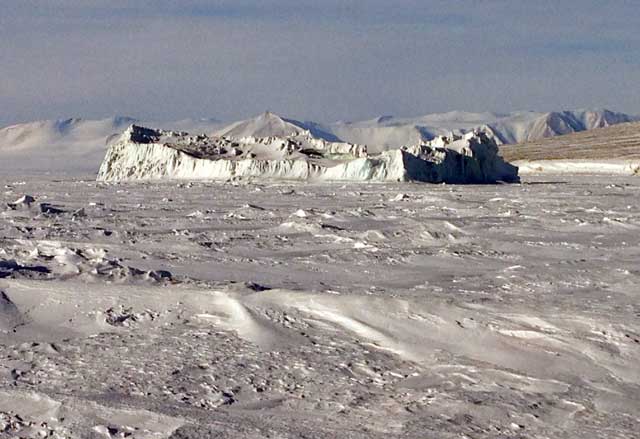
Photo Credit: Keros Johnson
An iceberg froze in McMurdo Sound en route from McMurdo Station to Marble Point.
Photo Credit: Paul Thur/Antarctic Photo Library
A crevasse in the shear zone near McMurdo Station is filled in during a previous field season.
Collin Stackhouse lightened the dark mood in early October playing the fiddle at the Coffee House. A large crowd of people flocked to hear his fiddle playing, able to forget the worries of the world for a little while. A dance at the Berg Field Center that turned into a costume party also helped to salve the somber mood around station, which began operations to move into caretaker status. Then the sun came out from behind the clouds. Funding was restored to the USAP, which started the process to rehire employees and restore the science program. On the operational side of the post-government shutdown, traverses to Marble Point, Black Island and the crevasse-riddled shear zone for South Pole Traverse got under way. Black Island Traverse completed its first run to carry supplies and water to McMurdo’s telecommunications facility about 20 miles away. The crew commented on how nice the weather and roads were this season, though a veteran chuckled that they used to complete the seven-hour, one-way trip in two hours in a pickup truck because the roads were much easier to compact on the sea ice back then. Due to bad road conditions in past years, Marble Point had not received a fuel shipment since 2010. Marble Point, located across McMurdo Sound, serves as a gas station of sorts for helicopters that support field camps in the McMurdo Dry Valleys The South Pole Traverse, which delivers fuel and some cargo to the USAP’s southernmost research station, has made a couple of trips to the nearby shear zone to fill in crevasses and “blobs” found by ground-penetrating radar in preparation for the two tractor trains that will leave this month. The shear zone crossing has been worked and reworked for 11 seasons since 2002, with blasting and filling of holes with snow. It has become harder to “mine” snow for the fills, and they are looking toward finding a new crossing by 2015. Anthony Powell’s labor of cinematographic love, Antarctica: A Year on Ice McMurdo locals laughed and squealed as they caught glimpses of themselves and their friends appearing throughout the movie. Robert Falcon Scott’s Discovery Hut The Halloween party, sponsored by the Cargo department, went off without a hitch. The creativity of the costumes was amazing. Waxed wrestlers, walking floral arrangements, a Pillsbury doughboy and even a performance by Cirque de Antarctique. What else could one ask for at a Halloween party than to see the best impression of Hulk Hogan ever? Winfly brings five planes to McMurdo Station in August and SeptemberPosted October 21, 2013
The skies above McMurdo Station The first plane to touch down at McMurdo Station’s Pegasus Airfield 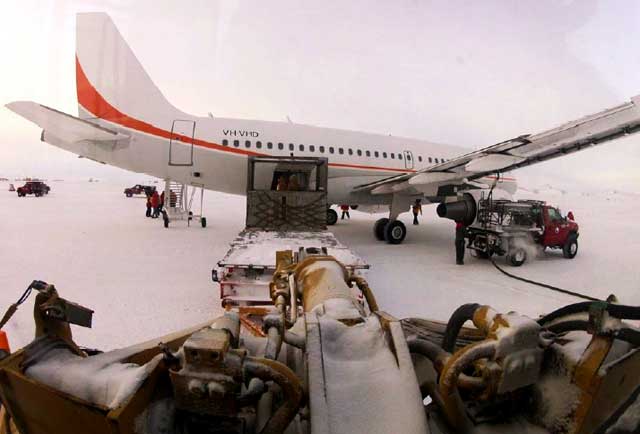
Photo Credit: Gareth Weaver
Cargo is unloaded from an Australian Antarctic Division Airbus A319 at Pegasus Airfield on Sept. 8.
The U.S. Air Force The two flights represented the first phase of what’s known as winter fly-in, or winfly, when a vanguard of support personnel arrive at McMurdo to help prepare the station for the busy Antarctic research season, which begins in October and runs through the end of February. Three more flights carrying about 100 people arrived the first week of September, using the Australian Antarctic Division’s Airbus A319 A number of projects were under way in September to prepare the station for the upcoming field season. Worked ranged from creating a temporary runway on the sea ice near McMurdo Station to repairing damage at Pegasus Airfield due to warm temperatures and a dust storm last season to a station-wide cleanup day at the end of the month. Day in the life: Tracking the movement of four people across winter darknessPosted July 19, 2013
Yes, we celebrated Midwinter’s Day on June 21. We had a feast fit for a five-star restaurant. Our dining room was decorated like a ballroom, and we wore our finest clothes while eating hors d’ oeuvres, dancing and carrying on a tradition that started with the early explorers like Scott and Shackleton. But what does a day look like at McMurdo Station It’s June 11 at 9:57 in the morning, and I’m at McMurdo Station in Antarctica. It’s the middle of the winter, which means I haven’t seen the sun since April 19, but I have felt the cold and wind and seen the Southern Cross at noon. To describe my job today, it’s best to think of Radar O’Reilly from MASH. I am monitoring three radios to my left, seven different frequencies in front of me, and on my right I can communicate with the South Pole Station The reason I’m here today is because a crew of four people left our base in two vehicles to traverse across McMurdo Sound to Black Island, where we broadcast and receive all of our satellite communications, including phone and Internet. The reason you’re reading this now — an email that I sent from Antarctica — is because it was sent from McMurdo to Black Island, then to Australia and finally to Denver. In Denver, my words hopped on the Internet and ended up in The Antarctic Sun. As the crow flies, Black Island is about 25 miles away, but there aren’t any crows in Antarctica or straight roads. By the time the Black Island tractor traverse gets to its destination, the vehicles will have traveled a little more than 60 miles, and it will take about eight hours. This traverse is like astronauts walking untethered from the International Space Station. They are headed to Black Island to do routine maintenance on the satellite receivers and generators. If the generators, receivers and modems are not regularly maintained at Black Island, then we would be both literally and figuratively left in the dark. This is my job today — monitoring the movement of four souls across the winter blackness of Antarctica. Station pulls together for winter-time medical evacuationPosted May 20, 2013
On Tuesday, April 16,the rumors around the dinner table started humming. The people in Fleet Operations knew they had a meeting first thing in the morning to discuss the white ice runway at Pegasus Airfield The ice runway? What was there to discuss? The ice runway is supposed to remain buried until August when we normally get our next flight. The next day it all made sense. One of our community members needed to leave due to a medical emergency, and he needed to leave quickly. 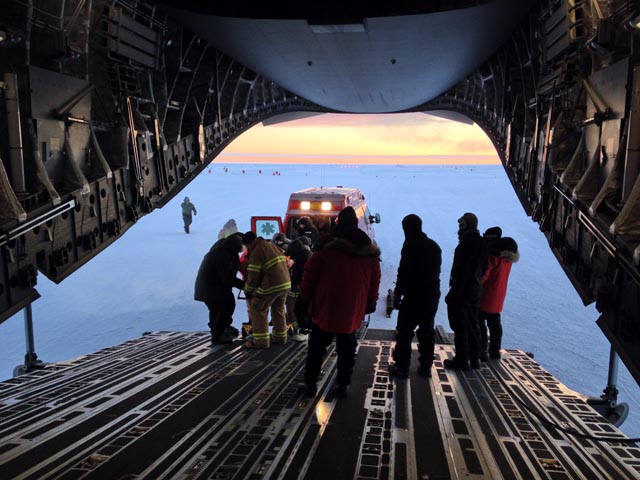
Photo Courtesy: Joint Task Force-Support Forces Antarctica
A C-17 Globemaster III crew from Joint Base Lewis-McChord, Wash., alongside aeromedical evacuation and critical care air transport team members, safely evacuate a patient from McMurdo Station, on April 22.
The ice runway was covered in up to 10 inches of compacted snow. The electricians would need to hook up power; the fuelies would need to build a fuel pit. Other tasks included setting up lights for the runway, heat for the buildings and many other things to ensure the runway was safe for a plane to land at the start of our winter. For many, their normal 10-hour shift became around-the-clock 12-hour shifts. The galley, once a buzz with rumors of a medevac, was now staying open later to feed those who were working atypical winter hours. The weather was the only entity in McMurdo Station It was projected to take more than a week before the Air Force Taking only six days to turn a snowfield into an Air Force-ready runway speaks for itself. We are a community dependent only on each other right now, and when our mettle was tested, we came together for one of our own. And we had to do it all over again in May when a second medical evacuation occurred. Cold weather can't disguise winter at McMurdo StationPosted April 19, 2013
McMurdo Station Wind gusts blowing more than 60 knots and temperatures dropping to degrees that would be warm if they were on the plus side, we learned quickly what can be in store for us this winter: Cold, cold and cold, with a seven-month extended weather forecast of cold and blowing winds. Even if we hadn’t read Antarctica for Dummies before coming down here, most of us probably had a faint recollection or inkling that winter at McMurdo would include cold temperatures. No one complained about the cold; the biggest problem with March coming in like a lion was that we haven’t had enough time to meet our 143 co-inhabitants of McMurdo. With the cold weather came face masks, goggles, scarves and our standard issue Big Red parkas. Even if my mother was stationed down here, I would not have been able to distinguish her from Jeremy the Plumber, as they would both be clad in the same attire. Most people dealt with this inability to recognize people by simply keeping their head down as they ducked in and out of buildings. I just started calling everyone “Mike.” There are seven “Mikes” in McMurdo this year. With 5 percent of the population named “Mike,” I was only wrong 95 percent of the time. In some aspects of my life, this is a huge improvement. And, when I was met by a cold stare (likely), then I’d run through the other popular names. There are five guys named “Rob” and four named “David” or “Ray.” Throw in a few named “John,” “Dan,” “Brian,” “Jason,” “Richard,” or “Bill,” and now you’re saying, “hello,” to almost 30 percent of our population. The women have proven to be a bit more difficult. Only two share the same name: Cynthia. And one insists on being called “Cindy,” because that’s her name. The Lion of March quit roaring just in time for us to celebrate Easter. With limited supplies, eggs and costuming, we did the best we could. We decorated beverage cans and it was eggcellent. Though it’s a good thing there aren’t any kids down here; our bunny lacked cute and cuddly. Winter under way at McMurdo after a few false startsPosted March 15, 2013
Winter has begun at McMurdo Station The start of the 2013 winter got off to a rough start for the 143 inhabitants of McMurdo Station this year due to mechanical delays of the last flight in Christchurch, New Zealand, and Mother Nature at McMurdo Station. 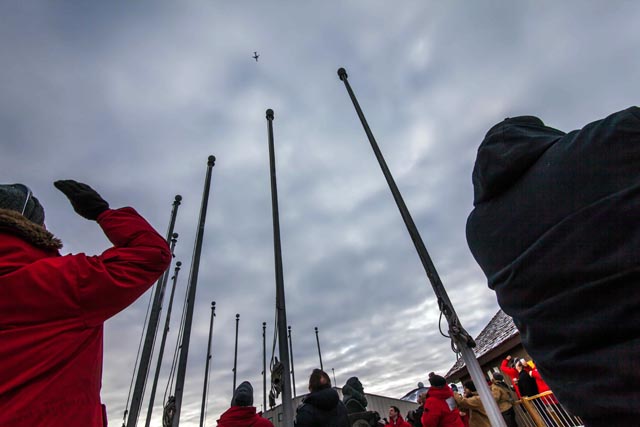
Photo Credit: Ben Adkison
McMurdo Station personnel look up to the sky from the Chalet administration building to watch the last plane of the 2012-13 summer season leave.
The 60 remaining summer participants should have flown north on March 5. There were going-away parties, tears and hugs the night of March 4. After the first delay kept those friends and co-workers one more day, there were still hugs, but less tears the night of March 5. By the time the plane finally took off on March 9, travel plans for the summer people had gotten cut short. Not to mention the fact these 60 people were still eating our freshies — real fruits and vegetables that will mostly be gone in just weeks. It seemed like the main form of saying goodbye on Saturday was a kick in the pants and a shove to the back to get them on Ivan the Terra Bus and to the airfield. Now, a few days into our winter season, we’ve had our first All-Hands meeting, first “Welcome to Winter Party,” first watching of the movie, “The Thing,” and we’re currently preparing for our first mass casualty incident (MCI) drill to test our preparedness in case of an emergency. The people to our left, right and across from us in the dining hall are the people on whom we will be depending for fun, work, friendship — and possibly to save our lives. Winter has begun at McMurdo Station. Yes, it really has, and we’re preparing for the worst, but hoping for the best. Summer season winds down with arrival of supply shipsPosted February 15, 2013
The holidays have ended and business around McMurdo Station The first to reach McMurdo Sound was the Russian icebreaker Vladimir Ignatyuk 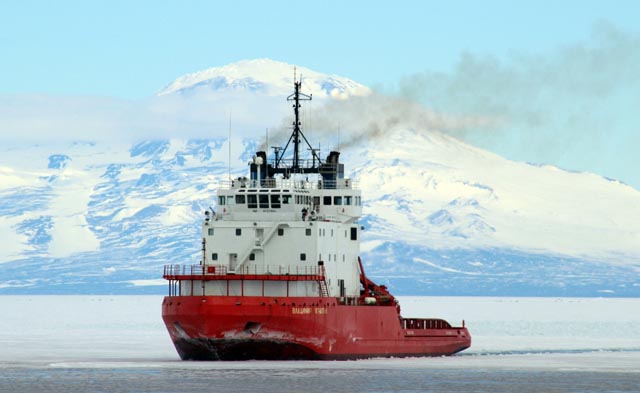
Photo Credit: Deb Wilfong
Russian icebraker VLADIMIR IGNATYUK cuts a channel through the sea ice into McMurdo Sound.
It will be a busy time on the waterfront over the next few weeks. The warmer weather this summer has made for challenges at the airfield, which delayed the return of the Air Force’s C-17 Globemaster III The station continued to receive passengers and supplies via the smaller Hercules LC-130 Sad days passed through McMurdo as news that three Canadian crewmembers of a Kenn Borek 
Photo Courtesy: Pam Hill
The Canadian flag is flown at McMurdo Station in honor of three men killed in a plane crash.
The Canadian flag was flown, flanked by the United States and New Zealand flags, which were in honor of those in support of the recovery effort. A book was made available for members of the McMurdo community to sign to send their condolences and words of comfort to the families. Elsewhere on station, science has picked up speed as members from deep field camps are arriving with their samples. One interesting study of note is a project out of NASA’s Astrobiology Science & Technology for Exploring Planets (ASTEP) Called IceBite, scientists and engineers are developing an ice auger and sampling bit for use on Mars. Ice-rich locations on Mars could have preserved biological material from when it was previously in a liquid state. The terrain in the McMurdo Dry Valleys McMurdo Station gets in a festive mood for DecemberPosted January 12, 2013
December is a festive month all over the world, and McMurdo Station One of the popular holiday events in town is the Christmas Acoustic Show at the Waste Barn. This show began in 2007 and evolved out of the Zimm Brothers Christmas Show that was previously held at the Coffee House. The Waste Barn is the central location for sorting and packaging trash on the station, but on this night, the space is transformed into a small club or concert hall, with holiday decor and artwork. Chairs are lined up for the more than 100 people in the audience. Typically, 10 to 12 performers or groups are invited from the community to play. The feel of the event is that of a private party. The music is great but even an off-key note receives equal applause. It’s a feeling that you are amongst family when you play in this town. The other popular musical event of the season is the New Year’s Eve outdoor concert, IceStock. The event began in the late afternoon with a chili cook-off and soloists performing on stage. The crowd slowly formed, as the evening gradually ramped up to full bands that got the crowd moving. There was even a performance by the local dance troupe with a few added extras. Baby New Year was present to help welcome 2013. Other holiday events included the town Christmas party at the Vehicle Maintenance Facility, complete with Santa and Mrs. Claus on the PistenBully. MAAG, the McMurdo Alternative Art Gallery, always draws local artists and craftsmen to show their works. Every year MAAG also holds an event on stage. This year it was a cabaret show, complete with an illusionist, belly dancer and a burlesque show, amongst other acts. The McMurdo Community Christmas Choir performed at various events including one at MacOps. MacOps is the radio call sign for the Emergency Management and Station Communication at McMurdo. They run the 24-hour communications center for the station and communicate with the various field camps. On this particular day, MacOps helped to spread holiday cheer around the continent through the high frequency air waves. The South Pole Choir also sang a few songs to some of the field camps. Each department typically has its own party to celebrate the season. The chapel had Protestant and Catholic services to remind us of the spiritual origin of the season. And, of course, the kitchen served up a feast for the town to enjoy. |
Home /
Around the Continent /
McMurdo Station Archives - 2013
"News about the USAP, the Ice, and the People"



For USAP Participants |
For The Public |
For Researchers and EducatorsContact UsU.S. National Science FoundationOffice of Polar Programs Geosciences Directorate 2415 Eisenhower Avenue, Suite W7100 Alexandria, VA 22314 Sign up for the NSF Office of Polar Programs newsletter and events. Feedback Form |

